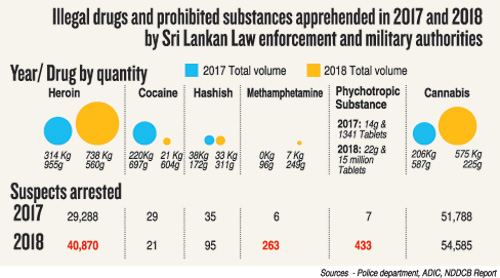News
More than 75% of rehabilitated drug users return to habit
Only a minimal number of drug users released from rehabilitation centres in Sri Lanka are cured of the habit with an alarming 75 and 80 percent of them relapsing, experts said.
While counter-narcotic efforts last year had some impact, awareness and rehabilitation need strong improvement, said Pubudu Sumanasekara, Executive Director of the Alcohol and Drug Information Centre (ADIC). There were 506 drug-related arrests per 100,000 population in 2017, indicating that drug abuse still affects 2.4 percent of Sri Lankans. Users were aged between 15-64, according to the National Dangerous Drugs Control Board (NDDCB). There was a significant increase in heroin, methamphetamine (also known as ICE) and psychotropic substance arrests last year when compared with 2017, police statistics show. “There is a misconception that ‘Kerala ganja’ is better than other variants so the demand for it has increased,” said SSP Dhanapala of the Police Narcotics Bureau (PNB). The price per kilogram of heroin has risen from 2018 to date owing to reduced supply, he claimed. Meanwhile, the use of methamphetamine is trending.
ADIC estimates that there are more than 80,000 drug users in Sri Lanka, with only half of them being reported. Law enforcement efforts to reduce supply has an effect on the local user base and builds awareness, Mr Sumanasekara agreed. Many drug traffickers have been forced to change their networks to outrun consolidated police efforts.
The cheapest narcotics can be found in Colombo, Mr Sumanasekara said. Street prices saw a slight increase last year, with cannabis single use quantity costing between Rs 300- 600. Heroin, which has the second largest reported user base, cost between Rs 500-1000 depending on purity.
Some publications and media broadcasts glamorised the narco culture and misinformed impressionable young people, he complained.
Last year the PNB with assistance from the Special Task Force (STF), other law enforcement agencies and the military netted the largest volume of narcotics to date. This year, the PNB wants to target traffickers to reduce supply, said SSP Dhanapala. “We want the major dealers and traffickers, and to intercept big consignments,” he explained. The PNB lost an officer, and several were seriously injured last year when drug dealers ambushed a team.
“We take the security and safety of our officers seriously and strict measures have been put in place” he said. “We can now call on the STF for high risk operations,” he pointed out. An insurance provider has offered free life cover for PNB and other officers doing high risk counter-narcotics work. Intelligence sharing and cooperation with partners is important, he said. A Bangladeshi Police team is now in Sri Lanka to assist investigators on the recent arrest of a Bangladeshi alleged to be part of a large drug trafficking ring.
The police are also planning a large-scale awareness programme. Some educational institutions withheld information from the police to avoid the school’s reputation being tarnished, SSP Dhanapala said. “This is a serious situation,” he stressed. “A student’s health and well-being must be the priority.” Schools, like other organisations, had a collective responsibility to society.
A multi-organisation schools awareness programme is starting tomorrow for students, teachers and administrators. The police also plan a four digit toll-free hotline to anonymously report drug abuse, dealing or trafficking. “People have begun to come to us with information,” SSP Dhanapala said.”It has been very helpful. We hope they bring us more leads in 2019.” But there is also a need for specialised community service personnel to provide essential after-care services, Mr Sumanasekara said. A majority of drug users relapsed on returning to their normal environments and associating with their communities. The current “centre type model’ is not cost-effective and needs rethinking.
Peer pressure, local environment, influence from sub-culture and individual relationships compelled rehabilitated persons to re-use narcotics due to lack of assertiveness in their characters. “There needs to be a cultural shift,” Mr Sumanasekara observed. Many repeat users told ADIC that, although they can stay away from drugs, they can’t escape their environment or community. Effective prevention and rehabilitation mechanisms, public awareness, empathy and support are paramount.
“The community also needs to realise that stigmatising users is counter-productive and that they have to be part of the solution,” he argued. “The community type rehabilitation model is more suitable for Sri Lanka and more cost-effective. We need a ‘total population approach’ towards prevention.”

